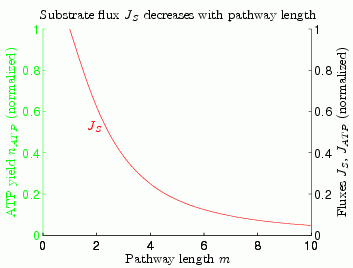
Survival of the shortest pathway: why is metabolic labour divided in nitrification?
Kinetic theory of optimal pathway length can explain the metabolic division of labour between ammonia-oxidizing and nitrite-oxidizing bacteria.
Keywords: Nitrification, Methane oxidation, Methylotrophs, Biofilms, Microbial specialization, Division of labour, Trade-off, Kinetic theory, Metabolic pathways
Winogradsky discovered in 1890 that nitrification, the process of oxidizing ammonia to nitrate, is carried out in two consecutive steps by two physiologically and phylogenetically distinct groups of bacteria: ammonia oxidizing bacteria and nitrite oxidising bacteria.
Step 1: ammonia oxidation to nitrite (AOB: Ammonia Oxidizing Bacteria)
NH4+ + 1.5 O2 → 2 H+ + NO2- + H2O
ΔGº' = -275 kJ/mol N or -46 kJ/mol e-, Eº' = 343 mV
Step 2: nitrite oxidation to nitrate (NOB: Nitrite Oxidizing Bacteria)
NO2- + 0.5 O2 → NO3-
ΔGº' = -74 kJ/mol N or -37 kJ/mol e-, Eº' = 434 mV
To date, no exceptions to this rule are known, but the reasons for this division of labour have not received much attention. We offer an explanation for this cross-feeding based on kinetic theory of optimal pathway design, which assumes that the production of enzymes as well as the presence of intermediates is costly and that the number of ATP generating steps is proportional to the length of the pathway. From these assumptions, the existence of an optimal pathway length follows which maximises the rate of ATP production. Shortening the pathway could therefore increase the rate of ATP production and growth, increasing fitness in environments such as enrichment cultures that select for fastest growth rate. However, there is a trade-off between growth rate and growth yield, since the longer pathway would have more ATP generating steps, thereby increasing growth yield, which has been shown to be advantageous when bacteria grow in clonal clusters, as is typical for biofilms (See the project on "Biofilms promote altruism"). We postulate the existence of bacteria that completely oxidize ammonia to nitrate. Isolation of these "lithotrophs missing in nature" requires selection for higher yield, for which biofilm but not batch enrichments might be used.
For more information, please consult our paper:
Costa E, Pérez J, Kreft JU (2006) Why is metabolic labour divided in nitrification? Trends in Microbiology 14, 213-219
Key references
- Bock E, Wagner M (2001) Oxidation of inorganic nitrogen compounds as an energy source. In: The Prokaryotes: An evolving electronic resource for the microbiological community, 3rd edition, release 3.7, Dworkin M (ed), New York: Springer-Verlag
- Broda E (1977) Two kinds of lithotrophs missing in nature. Z Allg Mikrobiol 17, 123-143
- Kreft JU (2004) Biofilms promote altruism. Microbiology 150, 2751-2760
- Kreft JU, Bonhoeffer S (2005) The evolution of groups of cooperating bacteria and the growth rate versus yield trade-off. Microbiology 151, 637-641
- Pfeiffer T, Bonhoeffer S (2004) Evolution of cross-feeding in microbial populations. Am Nat 163, E126-E135
- Pfeiffer T, Schuster S, Bonhoeffer S (2001) Cooperation and competition in the evolution of ATP-producing pathways. Science 292, 504-507